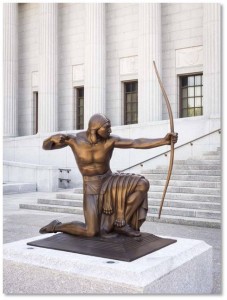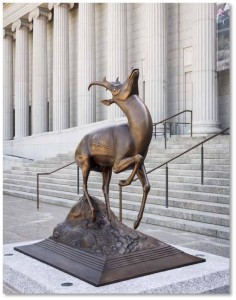This is the eighth post in a series about Boston’s bronze menagerie: animal statues that can be found throughout the city.
He’s called the Indian Hunter but the archer is only one part of this pair of statues outside the Boston Museum of Fine Arts. The second part is the Pronghorn Antelope, the animal that has just been struck by his arrow. The hunter, clad in loincloth and animal skin, has fired and the arrow is lodged behind the antelope’s right shoulder. The antelope rears back, frozen with shock, yet still graceful. The space between them is the unseen flight of the arrow.
The pair of statues in golden bronze stands on the marble courtyard in front of @MFA’s State Street Corporation Fenway Entrance. They were sculpted by Paul H. Manship in 1917 and this cast was made by the Paul King Foundry in 2002.
The original statues were commissioned in 1917 by Herbert L. Pratt of Glen Cove, N.Y. and Mr. Pratt’s estate later bequeathed them to the Mead Art Museum at Amherst College. This cast is one of two made in agreement with Graham Gund on condition that they would be donated to charitable institutions. The MFA’s hunter and antelope are a gift from Ann and Graham Gund.
Small Pairs
Smaller versions of this work can be found in museums across America and Mr. Manship originally designed the pair as statuettes to fit on pedestals at either end of the mantelpiece in his New York apartment. An admiring collector commissioned the two in large scale for his garden.
Oddly enough, many photographs of the two small pieces show the antelope facing the hunter. This would have made his shot impossible as he would have been firing diagonally across the antelope with the arrow making a U-turn in mid-air to enter the animal’s right shoulder. One can only surmise that these curators either didn’t notice the arrow in low relief or are unclear on the dynamics of bow hunting.
Boston’s hunter and antelope get the juxtaposition right, which shows that someone at the MFA was paying attention to detail. Also, most descriptions of these statues talk about lines that hark back to Ancient Greece and a flowing style that’s a precursor of Art Nouveau.
No one who wrote about these statues seems to wonder what I did, though: what tribe does the hunter belong to? Perhaps that’s because we just returned from Arizona and a visit to the Heard Museum of American Indian Art and History. Pronghorn antelopes (antilocapra Americana) are native to the American Southwest so that means he came from one of the tribes indigenous to this area. But there are many.
Mr. Manship liked to “translate” archaic themes into modern styles. The lion skin draped across the hunter’s left leg is a classical image, reminiscent of Assyrian art or Greek statues of Hercules. In a sense, this is Hercules as American Indian. The hunter’s hair style might tell us something about tribe but I suspect that it’s also more classical than accurate. There is a reason for this.
Paul Howard Manship
Paul Howard Manship was born in St. Paul, Minnesota, in 1885, one of seven children. He studied art in Minnesota, Pennsylvania, and New York City and served as an assistant to six sculptors, learning anatomy and modeling. He was inspired by Greek, Roman, Egyptian, and Indian art due to major excavations that were ongoing at this time. But he was also interested in modernism that was moving beyond the classical realism prevalent in his day.
He combined those two elements, ancient and modern, to create what the Smithsonian American Art Museum describes as, “decorative, highly styled, Neoclassical works.” The museum also calls Paul Manship the “country’s foremost exponent of Art Deco.” He had a studio in Gloucester, MA.
Paul Manship is best known for the gilded statue of Prometheus (1933) that decorates the fountain at Rockefeller Plaza in New York City. The Smithsonian American Art Museum, where he once chaired the board, has a gallery dedicated to his works. He died on January 31, 1966.
Directions to the Statues
 The Indian Hunter and Pronghorn Antelope decorate the plaza directly outside the MFA’s Fenway Entrance and can be visited at any time. Parking on the street is difficult in this area, particularly when college is in session or the Red Sox are playing at Fenway Park.
The Indian Hunter and Pronghorn Antelope decorate the plaza directly outside the MFA’s Fenway Entrance and can be visited at any time. Parking on the street is difficult in this area, particularly when college is in session or the Red Sox are playing at Fenway Park.
Your best bet is the museum’s parking garage on Museum Road. You can also park at the Prudential Center garage and walk over. Or take the T’s Green Line to the Museum of Fine Arts station.





You should have included a mention of the other American Indian statue at the MFA
Cyrus Dallin’s Appeal to the Great Spirit — sculpted in 1908 – 1909
from the MFA web page on the sculpture
1909
Cyrus E. Dallin (American, 1861–1944)
Place of Creation: Arlington or Boston, Massachusetts; Place of Manufacture: Paris, France
DIMENSIONS
309.88 x 111.12 x 260.35 cm (122 x 43 3/4 x 102 1/2 in.)
ACCESSION NUMBER
13.380
MEDIUM OR TECHNIQUE
Bronze, green patina, lost wax cast
ON VIEW
Bank of America Plaza on the Avenue of the Arts (EX07)
COLLECTIONS
Americas
CLASSIFICATIONS
Sculpture
Signed
Signed on base at right side: “C. E. Dallin 1908. [copyright symbol]”
Markings
Foundry mark on base at left side: JABOEUF & ROUARD. FONDEURS. PARIS”
Provenance
1909, cast in Paris; 1911, brought to the United States by the artist [see note 1]; 1913, sold by the artist to the MFA. (Accession Date: January 2, 1913)
NOTES:
[1] The artist exhibited this at the 1911 winter exhibition of the National Academy of Design and lent it to the MFA in 1912. It was purchased the next year by subscription, largely through a gift by Peter C. Brooks.
Credit Line
Gift of Peter C. Brooks and others
I would have, Ted, but the series is about animal statues, not Indian statues. I have excluded horses that exist only to support human figures from this category. I do, however, mention “Appeal to the Great Spirit” when I am giving a Dark Side of Boston tour for Boston By Foot. I stop at the Paul Revere Statue, also by Cyrus Dallin. When I have locals in my tour group, I make the connection between the two statues. Thanks for including all the detail.